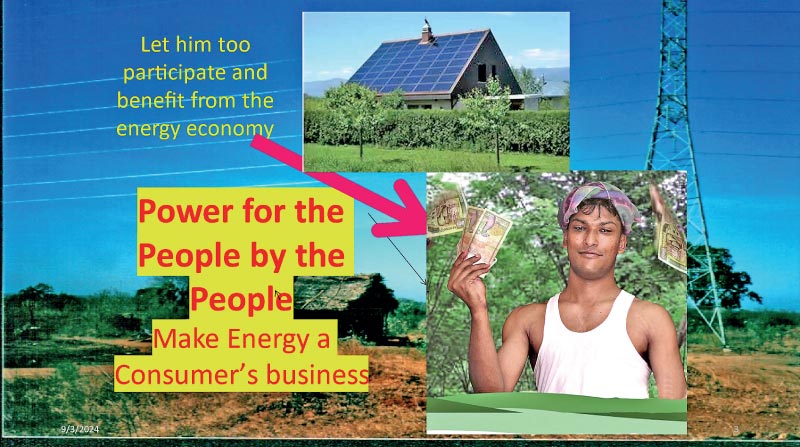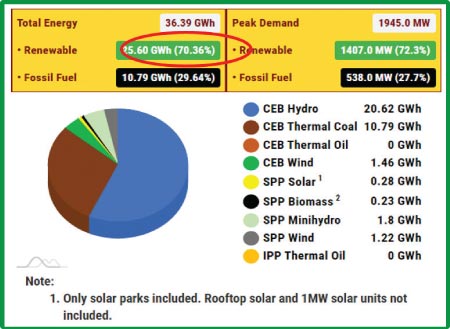Thursday Dec 18, 2025
Thursday Dec 18, 2025
Thursday, 17 October 2024 00:00 - - {{hitsCtrl.values.hits}}

|
 A new dawn
A new dawn
It is everyone’s hope that we may at last be moving towards a new dawn of prosperity and a future of sustainable growth in all aspects of economy and social well-being, with President Anura Kumara Dissanayake leading the way.
This hope is most prevalent in the Energy Sector, which has remained in the clutches of the fossil fuel lobby. While the transport fuels still remain nearly 100% dependent on imported fossil fuels, energy sources used for generation electricity generation have shown some progress in reducing dependence on such imports through the use of indigenous renewable energy sources.
Although the present contribution of only 12% to the total energy mix by electricity may not seem significant, it is more important to recognise that electricity, being the most desired and flexible form of energy in the sector, projects a future of nearly 100% electricity based Energy Sector, through the optimal utilisation of our bounty of nature. Sri Lanka is blessed with renewable energy sources of magnitude which is far beyond the energy needs of the country, covering all sectors, many fold even with the projected growth over many decades.
This is even more significant given the fact that Sri Lanka has no indigenous fossil fuels, which makes it imperative that we utilise this bounty to arrest the continual drain of valuable foreign reserves, as fast as possible. The advances in technology in recent years, enabling the development of such renewable energy without delay, should therefore be the highest priority of the new Government.
The recent Presidential election has brought the urgency of this issue into sharp focus, with the realisation that the previous unwise dependence on imported fossil fuels was the primary reason for the fall of President Gotabaya Rajapakse’s Government. The interim Government’s false claims of energy security also contributed to its defeat.
The more pragmatic vision of the new Government
The established policy of reaching a target of 70% renewable energy for electricity generation by 2030 has been confirmed by all presidential candidates, along with the goal of achieving zero emissions by 2050, with even more focus placed on this by the NPP. Under these circumstances, it is timely to discuss the way forward and the path President Anura Kumara Dissanayake would choose to achieve these targets, particularly since the portfolio of Energy is under his purview. We hope he will retain this portfolio after the parliamentary elections and the formation of the new cabinet of ministers.
It is therefore relevant to be reminded of the references made in the Presidential Manifesto on the Energy Sector, which has laid much emphasis and recognition of the bountiful renewable energy resources of Mother Sri Lanka. For the first time, policymakers have acknowledged the broader relevance and potential of these resources to play a major role in the economy, beyond the mere supply of energy to other sectors. The section of the Manifesto on energy, titled “3.10 A Secured Energy Centre – A Sustainable Revenue Resource,” highlights this recognition.
This is further elaborated by the item listed as the “Principles”
|
 The specific activities proposed
The specific activities proposed
The proposed activities in the manifesto support the above principles. If implemented with courage, conviction and combined commitment of all related agencies – unlike the present practice of totally disharmonious and opposing actions – the success of achieving the targets can be guaranteed.
The important message that should be brought to the attention of the President is the need to ensure no action or policy be permitted from now on that would hinder the progress or form barriers in achieving these goals. A distinct change in the attitude of the State agencies and officials is required. Hitherto that has been totally lacking with even the target of achieving the 70% RE goal not being assigned to any agency. This is due to the unfortunate situation prevailing in the State sector of there being no sense of accountability, either mandatorily or voluntarily. The most essential and urgent change needed is to mandate the task of achieving the stated goals to particular officials in the primary agency identified as the most appropriate when many agencies are responsible. Such mandate must flow from the Chairman Downwards with measurable Key Performance Indicators (KPIs) assigned with time targets. This is most easily done in the electricity sector immediately and the transport and other sectors of energy usage to follow without delay.
The present Government has brought in a number of new appointees to head the key agencies in the Energy Sector. We propose that these personnel inconsideration of their past record of knowledge and experience (unlike in the past when appointments were given to friends and relatives only irrespective of their suitability) be given strict instructions with the responsibilities for achievement of set targets and to pass down such responsibilities to their staff. Gaining the support and co-operation of other related agencies and over coming any barriers should be strictly their responsibility.
While the transport sector without any form of future vision or programs working in total ignorance of the major changes happening in the world would be difficult to be brought to this form of sustainable and future proof status, the already established and adopted polices in the electricity sector and the technological advances made even in Sri Lanka provides the base line on which such time based targets can be assigned.
The current target of 70% Renewable Energy based power generation by 2030 has proven to be quite achievable and non-challenging based on the recent experiences. In fact this target was surpassed in some days during the latter months of 2023 as shown below.
The first KPI to be issued
The potential saving of Rs. 113.65 Abillion annually could provide the means of lowering the consumer tariff by Rs. 7.5 per unit on average.
Should we pursue LNG relevant anymore?
About five years ago Liquid Natural Gas (LNG) was very much in discussion as a clean fuel and a possible intermediate solution to eventually eliminate the use of Coal and Oil for power generation. Perhaps under the prevailing circumstances then, when the Renewable Energy Options such as Solar and Wind had not gained the favourable status, both of technical acceptance and financial viability, this consideration may have been correct and timely. However, a much detailed analysis with wide stakeholder consultation is required at present before pursuing this option.
However, Sri Lanka not having any land based natural gas, and the challenging issue of the infrastructure required for the utilisation of imported LNG for economic use needed to be evaluated in depth. This still remains unresolved. At the same time being typical of the disjointed decision making process in Sri Lanka, the tender for the development of a 350 MW LNG power plant to operate on none existent LNG was awarded and the plant is nearly complete. It is reported that even in Australia with its own Natural Gas resource the cost of NG based power is reported to be exorbitant.
Under these circumstances although listed in the Activities in the Manifesto, we propose that this issue requires a much deeper and coherent analysis and evaluation before any concrete steps are taken. It is our opinion that Sri Lanka no longer needs any imported LNG. If we are fortunate to get funding to develop our Mannar resource viability of which is now established, it must be considered as the means of achieving the principle of Energy Economy as a source of foreign exchange.
But under no circumstances should we build any more LNG based power plants as listed in the current Long Term Generation Plant and still being promoted by some with their tunnel vision.
Conclusion
It is quite obvious that Sri Lanka is at the threshold of change in all aspects. This is most essential and urgent in the Energy Sector, which if handled properly would give Sri Lanka the much needed window of opportunity for economic prosperity. It is most encouraging that the present Government has clearly identified this opportunity. This article attempts to highlight the need to be warned of many decades of vested interests by many parties, which has kept Sri Lanka over dependent on imported fossil fuels thus prevented the flow of such prosperity to the people. The danger also exists of such elements trying to propagate antiquated principles and themes, with the underlying objective of keeping Sri Lanka trapped in fossil fuels for obvious reasons.
